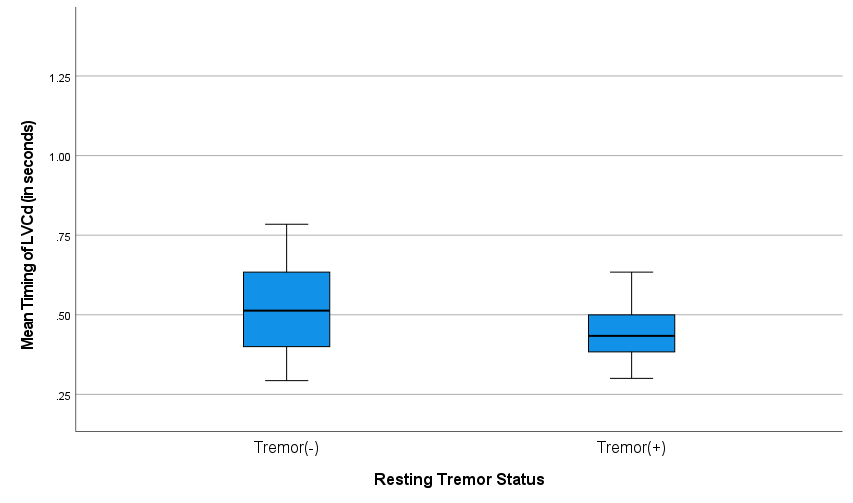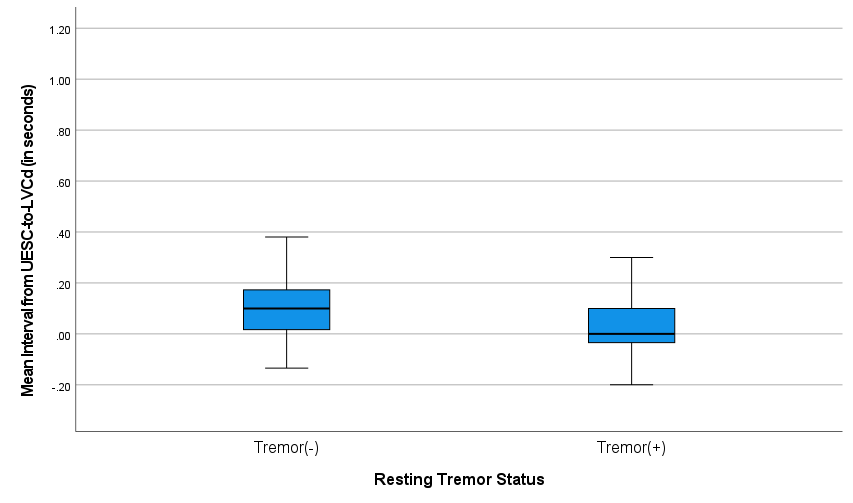Category: Allied Healthcare Professionals
Objective: The objective of the project was to investigate how the presence of resting tremors in oropharyngeal structures impacted swallow timings and duration measures to inform clinicians how these tremors may impact an individual’s swallow.
Background: Resting tremor in oropharyngeal structures including the lips & tongue and the larynx have been documented in people with Parkinson’s disease (PwPD)[1, 2]. Much of the research investigating tremors in oropharyngeal or laryngeal structures has been performed in speech or voice function[3]. To our knowledge, no investigations of how the presence of resting tremor during videofluoroscopic swallow studies (VFSS) impact swallow function are available.
Method: A retrospective analysis of previously conducted VFSS on 35 patients diagnosed with idiopathic PD was performed to examine swallow differences in those with resting tremor [4] during VFSS (Tremor+) and those without (Tremor-). The presence of tremor was identified during VFSS review by the second author and confirmed by the first author. Various swallow timing measures collected included time to laryngeal vestibule closure (LVC) & duration of LVC (LVCd), and timing intervals of upper esophageal sphincter (UES) function. A multivariate analysis of covariance (MANCOVA) was performed to determine group differences while controlling for bolus volume and consistency.
Results: 63% of subjects showed evidence of resting tremor during VFSS. MANCOVA results indicated a significant main effect of group on swallow timing (F=2.45, p = 0.01). Between subjects effects indicated that LVCd (F = 16.81, p = <0.001) and the interval between UES closure (UESC) and LVCd (F = 13.19, p = <0.001) were significantly shorter in Tremor+ subjects compared to Tremor-. Effect sizes for unequal groups (Hedge’s g) indicated medium effects of 0.66 and 0.57 for LVCd and UESC-LVCd intervals respectively.
Conclusion: Significant differences may manifest between PwPD who present with oropharyngeal tremor and those that do not. Decreases in the duration of airway closure and the interval between the completion of airway & UES closure during swallowing may suggest incoordination of airway closure and esophageal mechanisms in patients who present with tremor in the oropharynx. Substantially more research is needed to investigate the underlying cause of these differences and clinically relevant outcomes (e.g., aspiration).
References: [1] Hunker, C. J., & Abbs, J. H. (1990). Uniform frequency of parkinsonian resting tremor in the lips, Jaw, tongue, and index finger. Movement Disorders, 5(1), 71–77. https://doi.org/10.1002/mds.870050117
[2] Zarzur, A. P., Duprat, A. C., Shinzato, G., & Eckley, C. A. (2007). Laryngeal electromyography in adults with parkinson’s disease and voice complaints. The Laryngoscope, 117(5), 831–834. https://doi.org/10.1097/mlg.0b013e3180333145
[3] Broadfoot, C. K., Abur, D., Hoffmeister, J. D., Stepp, C. E., & Ciucci, M. R. (2019). Research-based updates in swallowing and communication dysfunction in parkinson disease: Implications for evaluation and Management. Perspectives of the ASHA Special Interest Groups, 4(5), 825–841. https://doi.org/10.1044/2019_pers-sig3-2019-0001
[4] Deuschl, G., Bain, P., & Brin, M. (2008). Consensus statement of the movement disorder society on tremor. Movement Disorders, 13(S3), 2–23. https://doi.org/10.1002/mds.870131303
To cite this abstract in AMA style:
M. Dumican, K. Harper. The Effect of Oropharyngeal Resting Tremor on Swallow Timings in a Clinical Cohort of People with Parkinson’s Disease [abstract]. Mov Disord. 2022; 37 (suppl 2). https://www.mdsabstracts.org/abstract/the-effect-of-oropharyngeal-resting-tremor-on-swallow-timings-in-a-clinical-cohort-of-people-with-parkinsons-disease/. Accessed December 16, 2025.« Back to 2022 International Congress
MDS Abstracts - https://www.mdsabstracts.org/abstract/the-effect-of-oropharyngeal-resting-tremor-on-swallow-timings-in-a-clinical-cohort-of-people-with-parkinsons-disease/


